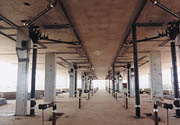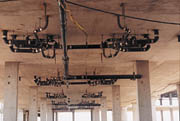
It used to not matter if a hotel didn't leave the lights on for you. In the "wee" hours of the morning you could always figure out where the toilet was. The tub was on one side and the lavatory on the other-so you naturally went for the middle. After all, how many ways can you arrange a three-fixture bath group?
The recent boom in the hotel building industry has changed all that, as hotel chains strive to differentiate themselves from one another. Fixtures no longer line up on a common wall-some are skewed at odd angles or located on opposite walls. Fixtures are also being added to the basic three. A bar sink, two lavatories and a stand-alone shower are common. Residential hotels have kitchen sinks and dishwashers, and suites often have bidets.
All of this creates unique challenges for the building professional. Architects must incorporate these items without sacrificing valuable square footage. Structural engineers must account for additional slab penetrations that can affect the integrity of the building. Mechanical engineers are faced with the task of providing the necessary system support in an ever-shrinking ceiling/wall space (see architect). Finally, mechanical contractors must find a way to install these systems and still make a profit in a very competitive industry.
The sanitary drainage system is arguably the least flexible of all the building systems. They are mainly gravity operated and depend on proper and sufficient slope of horizontal lines for successful operation. Past innovations in sanitary drainage have focused on installation procedures. As room layouts remained constant, however, they did little to accommodate the aforementioned challenges. The introduction of the SoventR Single-Stack Drainage, Waste and Vent system signaled a departure from so-called "conventional" methods and provided an innovative way of safely transporting wastes from the plumbing fixtures to the main sewer. Acceptance of this technology was slow, as it is with any new product in the plumbing industry. Through a combination of testing, monitoring and education, Sovent has become a hotel industry standard in recent years.
The History of Sovent
Sovent was developed in the 1950s by Fritz Sommer in Switzerland. His work was largely motivated by a need for resource-conserving construction methods and consisted of a scientific approach, rather than the trial and error method previously used in sanitary drainage. Hydraulic and pneumatic characteristics of intermittent flows were studied and simulated in a ten-story testing tower complete with fixtures and instrumentation. He discovered that controlling the flow within the drainage system eliminated the need for large amounts of vent pipe associated with "conventional" drainage systems. His patented Sovent fittings had a unique internal geometry that accomplished the necessary venting requirements within the same pipe as the drainage itself, thus conserving many resources. Once perfected, marketing rights, including permission to use the Sovent trademark, were granted to other industrialized countries around the world. Long after the initial development, Sovent continued to be tested and evaluated by government agencies and independent laboratories. Both laboratory and actual field installations have been tested and monitored. It remains the most thoroughly tested DWV system to date.Sovent entered the U.S. marketplace in the late 1960s through efforts by the Copper Development Association. Although no longer available in copper/brass, Sovent is offered in many materials, including HDPE, stainless steel and cast iron. Cast iron Sovent has been available since 1977 and offers the same ease of assembly and noise suppression characteristics of hub-less cast iron.
Sovent systems target the hotel industry; however, any project exceeding two stories in height and where people spend the night would benefit from its use. Several of the largest hotels in the world use Sovent, and well-known hotel chains continue to accept or specify its use wherever possible.
Breaking It Down
The Sovent system controls the flow within the pipe to keep pressure excursions from exceeding +/-1 in. of water column, which is the standard for sanitary drainage systems. The system consists of a vertical stack that is open to the atmosphere, horizontal branches and run-outs to each fixture, a Sovent aerator fitting at each typical floor level and a Sovent de-aerator fitting at the base of the stack or at any horizontal stack offset. Looking at each component individually will give us a better understanding of how they work together to balance the internal pressures and protect the trap seals.The Stack
The Sovent stack conveys waste from the upper levels of the building to the base of each stack. The stack begins just above the bottom-most de-aerator fitting and continues to just above the highest fixture connection. This will include any horizontal stack offsets located at intermediate levels. Unlike "conventional" stacks, the Sovent stack is not permitted to telescope in size, as it functions for both drainage and venting purposes. The Sovent stack will penetrate the roof to the atmosphere. In some cases, such as combining stack vents or where long horizontal vent offsets occur, the piping through the roof will be larger than the stack size. Sovent systems have no height limitation, and sizing is determined solely on the number and type of fixtures connected.
Flow through a vertical stack will cling to the interior wall surface and proceed downward in a swirling motion, leaving the center portion as an open airway. As long as this airway exists, there exists a balance of pressures within the stack. Left uncontrolled, the flow will increase in speed to a point known as terminal velocity and meet sufficient air resistance to flatten out until it forms a complete cross-sectional blockage of the tube. The resulting slug of water can create significant positive and negative pressures ahead and behind the flow. These pressures may cause trap seal failures through induced siphonage and/or blowback. The Sovent system eliminates the formation of the "hydraulic plug" and maintains a core of air throughout the vertical stack.
Horizontal Branches and Run-outs
The horizontal branches and run-outs connect to the plumbing fixture and transport waste to the Sovent stack. In this area, the liquid flow remains on the bottom portion of the pipe and venting occurs in the top portion. Sovent branch sizing criteria allocate approximately 75% of the cross-sectional area for venting purposes. Sovent branch design remains the key to flexibility, and the developed length limitations that exclude additional re-vent piping far exceed those of "conventional" systems. Two-inch and three-inch pipes may extend up to 15 feet from the stack, while a four-inch pipe is permitted to extend to 27 feet. The branch size may telescope, allowing a possible run-out of 57 feet without a return vent pipe. Developed length is determined by measuring along the centerline of all horizontal piping located in the ceiling and/or wall space. The vertical drop distance is not included in the calculation.Sovent branch run-outs typically shown have been subjected to some criticism. The system has been termed "oversized" and/or "a combination waste and vent system." Sovent branches are sized to accomplish both drainage and venting within the same tube, so over-sizing is a matter of semantics. Combination waste and vent systems tend to be very restrictive in the type of fixtures permitted and are often associated with only one level. Sovent is a multi-story application system and has little or no restriction on fixture type.
Another criticism is that Sovent systems use "S-traps" that are prohibited by most plumbing codes. A Sovent system does not use the traditional "S-trap" configuration, which is susceptible to self-siphonage. Siphonage can occur when the fixture's tailpiece, trap-arm and vertical drop are completely filled and the supply is abruptly halted. This may cause depletion of the trap seal and allow sewer gases to enter the room. A typical Sovent branch connection to a lavatory would consist of a 1-1/4" tailpiece, a 1-1/2" trap-arm, and a 2" vertical drop. Sovent systems are open to the atmosphere and gravity operated, making it impossible to completely fill the 1-1/2" trap-arm with a 1-1/4" tailpiece-much less the 2" vertical drop. As the flow leaves the trap-arm, it begins the swirling motion leaving the center of the vertical drop open with air. In this manner, self-siphonage is eliminated.

Aerator Fitting
The third component of a Sovent system is the aerator fitting. Aerators are placed in the vertical stack, usually at each typical floor level, and must remain in a full upright position. They contain no moving parts and require no special tools for maintenance. Their ability to balance the pressure excursions stems from the geometry of the full-size waterways through the body of the fitting.Two distinct chambers are found in the body of the aerator fitting. One is called an offset chamber and is where flows from the upper floors enter the fitting and actually "offset" around the horizontal branch inlets. This offset is designed to reduce the flow velocity and also break up any "hydraulic plug" formation associated with terminal velocity. Once leaving the offset chamber, it will again cling to the interior surface of the pipe, leaving the center area open for air. This occurs as the flow reaches aerator fittings at each floor and does not allow the flow to reach full terminal velocity. It also eliminates the need for the "yoke-vent" required in "conventional" systems. Floors without fixtures may use an "in-line" offset instead of an aerator as the velocity reducing mechanism. This offset will consist of standard 1/8 and 1/4 bends. Vertical distance between aerators and/or "in-line" offsets must not exceed 20 feet. Current building designs employ approximately 10 feet between floors, making this requirement easy to attain.
Interior baffles are situated to control the effects of flow through the system. To guard against blocking the cross-sectional area of the stack with a horizontal discharge, a second chamber is provided adjacent to the offset chamber. This mixing chamber is completely separated from the vertical stack flow through the use of a separation baffle. As horizontal flow enters the aerator fitting, it must transition to a vertical flow before smoothly uniting with any stack flow. These actions take place on an intermittent basis, as both stack and branch flows may not be present simultaneously. At the top of the separation baffle, a vent aperture or opening can be found. This provides the venting action between the branches and stack, which balances any pressure fluctuations that may occur. This aperture is also located properly to guard against fouling from the stack flow.
A second baffle is located perpendicular to the separation baffle in the mixing chamber. This will prevent cross-flow from opposing branch inlets. Aerator fittings have several branch inlets available for a variety of fixture layouts. Unused inlets can be blanked off during manufacturing to reduce space requirements or they may be capped for future additions and alterations. Soil branches from water closets, clear-water waste branches the same size as the stack and clear-water waste branches one pipe size smaller than the stack must connect to an aerator fitting. A clear-water waste branch that is at least two pipe sizes smaller than the stack size may connect directly to the Sovent stack, as the discharge would not be sufficient to block the cross-sectional area of the stack.

De-aerator Fittings
The final component of the Sovent system is the de-aerator fitting. It is located at the base of each stack and at any horizontal stack offset. It is designed to effectively deal with the pressure fluctuations that occur when vertical flow transitions to horizontal flow. Flow velocities are significantly reduced during this transition, and additional flow moving at its original velocity can cause a wave to form in the horizontal portion of the pipe. This phenomenon is referred to as hydraulic jump, and in some cases, can cause a complete cross-sectional blockage of the horizontal pipe. Similar to the "hydraulic plug" that can form in vertical stacks, this can lead to positive and negative pressures that exceed the limits for trap seal retention. Its severity is dependent upon the quantity of flow and the corresponding velocity. Hydraulic jump occurs to a much lesser degree in SoventR systems than in traditional piping arrangements due to inherent lower velocities. In addition, flow quantities are being reduced through the use of water conserving fixtures. The potential does exist, however, and the de-aerator fitting has two features designed to overcome these adverse effects.The first feature is an internal nosepiece. This nosepiece again reduces the flow velocity prior to the horizontal transition. It also allows the air and waste to separate, thus balancing the internal pressures.
The second feature of the de-aerator fitting is the Pressure Relief Line (PRL). The PRL outlet is located on top of the de-aerator and is routed from the de-aerator to the horizontal drain. It connects to the horizontal drain above the centerline at a minimum distance of ten pipe diameters downstream from the stack. These ten pipe diameters are based on the stack size (i.e. 4" stack = 40" minimum), and this places the PRL connection beyond the hydraulic jump zone. Pressures that may occur within this zone can now be relieved through the PRL and subsequently balanced to eliminate trap seal failure. As the flow continues past the PRL connection, all wave activity has ceased and the top portion of the pipe is maintained with air. Fixture connections are permitted to the horizontal drain and PRL, which will eliminate the need for an aerator fitting at that level. Connections into the horizontal drain shall also meet the minimum distance requirement while being upstream of the PRL connection. The PRL connection from the de-aerator fitting at the lowest level of the stack will terminate the Sovent system, and all fixture connections downstream of that point must be vented by "conventional" means.
Different, Yet the Same
Sovent represents a departure from traditional sanitary drainage methods by eliminating the separate vent stack and all individual re-vent piping. Yet many aspects are the same as "conventional" systems. The system must pass a standard water test to ensure there are no leaks. The piping must be supported properly and securely; however, there are no additional support requirements associated with the Sovent system. Clean-outs are needed for routine maintenance and should be installed in accordance with local code requirements. Properly sloped horizontal piping is vital to gravity-operated systems, and Sovent uses the same 2% requirements found on "conventional" systems. Installed slopes of 1% are permitted, but the capacity of the horizontal piping is reduced by 20%. Sizing a Sovent system is similar as well, as fixture unit values are used in conjunction with loading tables; however, it is important to follow the published Sovent sizing tables since values differ slightly. Other than different developed lengths and slightly different loading tables, the Sovent system presents little in the way of a learning curve. So, how can a tested and proven DWV system that eliminates virtually all the vent piping help building professionals?Sovent requires less chase space, which the architect can use for additional living area. Less ceiling space is needed, which can reduce the overall height of the project. The structural engineer will have fewer slab penetrations as vent stacks are eliminated. Remote floor-mounted fixtures such as showers no longer require the sleeve for a re-vent. The mechanical engineer can more easily coordinate all mechanical systems within the chase space since the crossing of sanitary piping is no longer necessary. Finally, the mechanical contractor has a means to reduce costs and competitively bid projects. In addition to less pipe, Sovent reduces the number of fittings, couplings, hangers, riser clamps, sleeves and fire proofing, in addition to the associated labor costs for these items. Many contractors use Sovent as a standard proposal in value engineering.
As hotel projects get bigger and fancier, the lines between hotels and condominiums become blurred. Gone are the days of the standard CAD detail for bathroom layouts. Sovent has the design flexibility, proven track record and cost effectiveness needed for a healthy hotel construction industry. So, if you are likely to encounter these new hotels in the near future, bring a flashlight...just in case.

